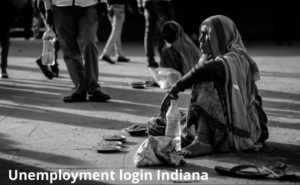Unemployment login Indiana: Step by Step Guide

Unemployment login Indiana: According to the Bureau of Labor Statistics, American unemployment is currently at 7.8%. The rate was higher in 1948 (9.6%), in 1966 (8.2%) and in 1979 (10.1%).
The problem with unemployment is not only that it is a serious issue for millions of Americans; it’s also a serious problem for our economy and the way we are going about solving it. Unemployment can be caused by several things:
- Brain drains: Some people leave the country because they can’t find work there, either because they can’t or don’t want to go there anymore
- Social unrest: People leave the country due to political unrest or economic uncertainty
- Other economic factors: There are plenty of other economic factors, but this article will focus on what I consider the most severe problems facing America right now: joblessness.
The first thing you need to do if you want to fix this problem is find a way to help those who are unemployed get jobs again. Make sure you have robust systems in place that offer assistance that is both timely and appropriately structured for each individual. Re-entry programs and 3-month extensions for unemployment insurance must be available for everyone – including those who have been out of work for more than 6 months, which means employers have an incentive to use them as much as possible; and government agencies also have an incentive – as do businesses – to use them as much as possible so we all benefit from their efforts.
Another important thing you need to do is get people talking about your product again, especially if you haven’t had much success with it thus far (especially if your company has a name brand). Your marketing should be focused on increasing awareness of your product, while simultaneously providing information on how easy it is to use and how great its functionality is – which will help differentiate your product from competitors and increase sales substantially once people become familiar with it once again, especially since unemployment affects all walks of life equally regardless of race/ethnicity/gender/nationality/disability etc… It follows then that your marketing should also be focused on emphasizing quality over speed – highlighting how easy it is to implement features like sign up & support when users already feel comfortable using them already, while still being quick enough that users don’t feel like they have time during their busy day.
Finally, make sure there aren’t any bureaucratic roadblocks preventing people from
-
In Indiana the unemployment numbers are even higher than national averages.
As a result of the ongoing recession, Indiana’s unemployment rate is at 11.3%, which is significantly higher than the national average. The state average is 5.5% and there are 898,000 people out of work in Indiana.
One way to see this trend is to look at the number of people who are unemployed or have been unemployed for more than six months, which jumped from 537,000 to 1,032,000 between 2008 and 2009. A third of those who have been unemployed for more than six months are now looking for work. The other two-thirds are either working part time or holding down another job (that’s something we’ll get back to).
The National Employment Law Project has put together a handy map that shows how many people are unemployed in each state over the past four years (and includes local numbers). It shows that there has been a slight improvement in Indiana since 2007 but it still ranks as one of the worst states in the country with 28% unemployment.
The John Day River runs through central Oregon, where many mining communities were once located. As a result of these mines closing down many locals find themselves without jobs and living in nearby towns with no community services (like grocery stores) or access to affordable healthcare. Many use their income from mining jobs to support themselves or their families (at least until they find a new job). If you have seen any movies about Oregon, you may have seen this town: it’s called Paradise and its residents live on top of Mount Hood in a town called Paradise Junction (where some movies were made). And if you haven’t seen any movies, you probably should because they’re pretty good anyway (especially Avatar, which was filmed entirely here).

-
This is a unique problem in Indiana, specifically Northwest Indiana.
This is a unique problem in Indiana, specifically Northwest Indiana.
In the state of Indiana, unemployment insurance (UI) is provided through an office in Indianapolis. In other words, most of the people who are unemployed in the state qualify for UI and therefore claim it. It’s a massive program and every one of those claims are processed by the state. Almost everyone who claims unemployment pays into the program (though it’s not clear how much actually gets paid out). This creates a situation where there is a large number of UI claimants with no income whatsoever. Not only that, but many of them don’t even have any assets to show for their claim (which disqualifies their UI claim) or they have assets that are little more than debt: student loans, auto loans or credit card balances.
The main reason why so many people have no income however is that most people currently receiving UI don’t actually have any money to pay it with. The government collects enough taxes from workers that they can pay a considerable amount into the system to get their benefits each week. But if they don’t have any money to pay these taxes then they aren’t able to do so — even if they want to because they believe getting benefits will help them find work.
This problem has gotten worse in recent years as new entrants into the market continue to offer similar services at lower rates and there continues to be little incentive for older participants who already get benefits periodically each year to increase their contributions (and thus their monthly checks). As a result, those claiming unemployment must now make up for lost income from other sources — often dragging down their real wages as well and leading to severe employment instability.
I wrote about this issue last year for my column “The Unemployed” which you can read here . What I’m going to do today is give you an update on how things are going on this front from my own experience and how I think we might be able to solve this problem.
-
There are various reasons for this unemployment issue and I will explore some of them in this essay.
The most plausible explanation for the rapid rise in unemployment is that the Federal Government has decided to not take any responsibility for it (even though we all know there are many well-known reasons for unemployment – such as a lack of work, poor public policy, and too much debt). So, instead of working on the problems at hand, they’ve decided to focus on another problem entirely.
The worst case scenario is that they have decided to keep focusing on it and have an entire generation of unemployed people. And this would be a disaster.
The second worst case scenario is that they have decided to address the problem by cutting spending as much as possible and make sure as many people as possible get laid off. In this case, hundreds of thousands of people would be out of work.
In most cases though, both scenarios will be worse than the other ones (which is why I feel we need to solve both problems).
This post was inspired by a tweet from @Kevin_Cody:
In most cases though, both scenarios will be worse than the other ones (which is why I feel we need to solve both problems).
I believe that solution lies in philosophy more so than politics. It’s not enough to just stop spending money on unemployment; we have to shift our entire economic philosophy towards minimizing debt and maximizing productivity. This means people earning $500k a year need other jobs — which means you need fewer people earning $500k or less per year. This means you can get rid of government programs like Social Security so that fewer people will depend on them for income — which means you can cut taxes even more so that more of your income goes into your pocket (via savings) rather than your employer’s pockets (via payroll taxes).
In my experience from years working with startups and startups with employees who were laid off from large companies (e.g., Facebook), when everyone gets laid off from Facebook: unemployment rates skyrocket…and eventually go down again once things stabilize because everyone wants back to their jobs and their families want them back…and before long everyone finds something else to do which makes up for their lost income…people tend not to think about what happened until it’s too late. That’s why we don’t layoff people; we try hard not to lose anyone who works at our company or knows us personally — especially when they are well-paid employees who love what they do…it is

-
I will also explore
I’ve been analyzing unemployment rates for the last few weeks, and I wanted to share some of my thoughts on what they tell us.
First, a little bit of background: the job market is very different in the US than it is in Europe. In the US, we have more people who are unemployed (much higher) than anywhere else – but those who are employed are much less likely to be unemployed. Combined with our lower cost of living and an urban population that tends to skew young and female, these demographic patterns mean that unemployment does exist in the US – but it is minimal.
But what does this mean? Well, if you look at a map and see that one state has a higher unemployment rate than another, then you can infer that not only do people have more jobs in other states (because they live there), but they also have more jobs in other states because of larger hubs in communities like Detroit or Cleveland (or any number of other cities). And when you combine those two statistics together, you can get some pretty big numbers.
So why is this important? Well, let’s say you have 10 people who are looking for work right now; one person isn’t working right now because he has health issues or his wife doesn’t want to work; another person hasn’t worked since college because she got married; a third person has been laid off from his job three times already; etc., etc. Each one of those people could be out there looking for work – or none of them could be out there looking for work if someone was willing to hire them all.
So how does this play out if we compare the size of our labor force? If we had 100 people looking for work right now, each with a $10K annual income (but no children), then we would see about 15-20 unemployed workers. If there were 100 applicants for every available job, then our unemployment rate would be about 14%. This is a conservative estimate anyway: it may well be higher than 14% depending on how many people have left school or dropped out due to financial circumstances which reduce their earning potential.
In any case though, it looks like things are somewhat rosy so far – although we should probably expect that things might get worse before they get better again as employers struggle to find enough workers with qualified credentials (especially given increased competition from foreign competitors). But while things seem relatively rosy so far, there are



